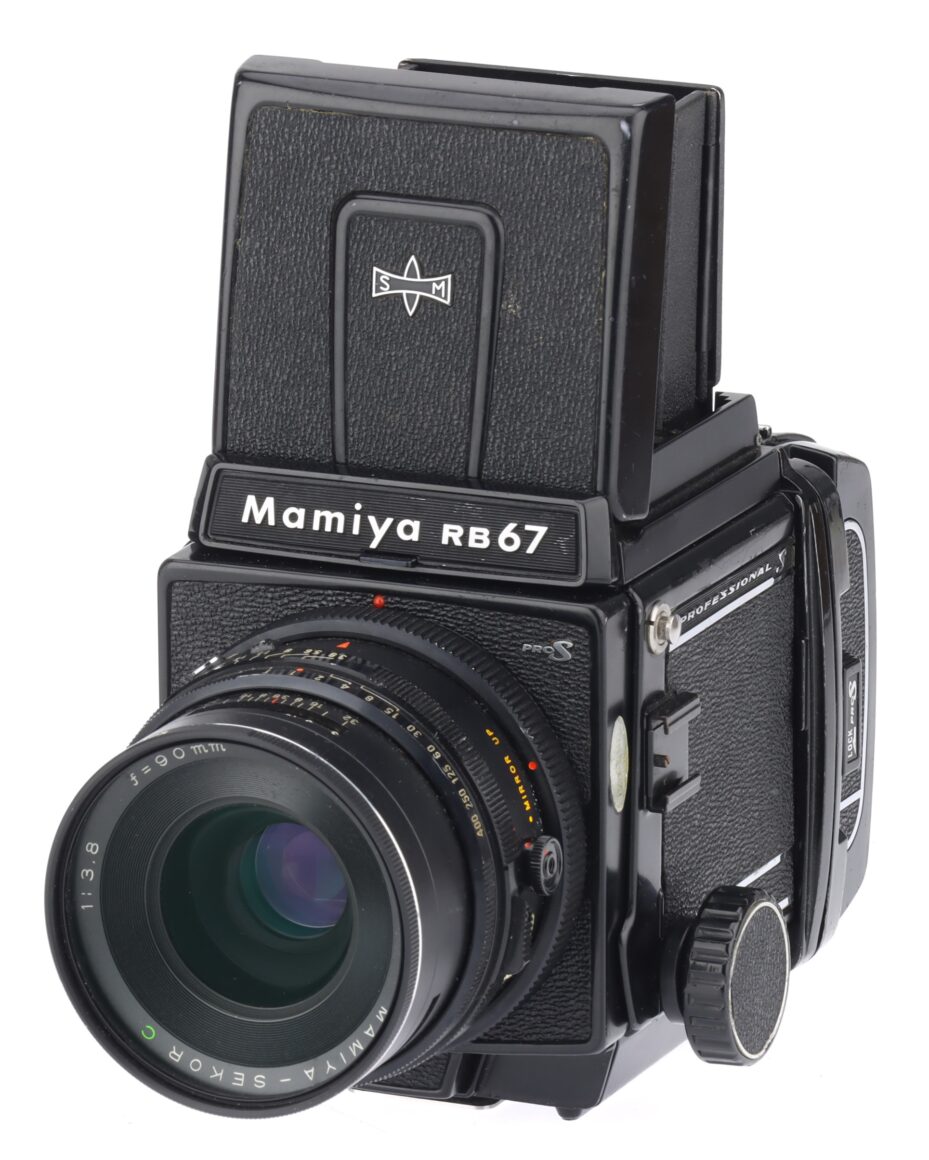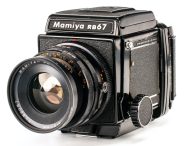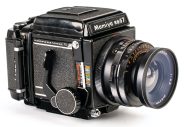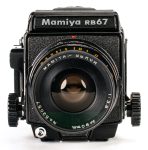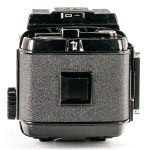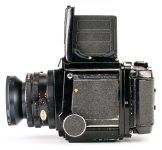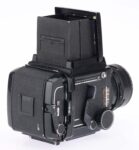Mamiya RB67 Professional
Medium format MF film SLR camera
Specification
| Production details: | |
| Announced: | 1970 |
| System: | ● Mamiya RB67 (1970) |
| Format: | |
| Maximum format: | Medium format 6x7 |
| Film type: | 120 roll film |
| 220 roll film | |
| Mount and Flange focal distance: | Mamiya RB67 [111mm] |
| Shutter: | |
| Type: | In-lens leaf shutter |
| Exposure: | |
| Exposure metering: | None |
| Exposure modes: | Manual |
| Physical characteristics: | |
| Weight: | 2595g |
| Dimensions: | 139x104x226mm |
Manufacturer description #1
Because the 6x7 format can be enlarged to 8x10 with virtually no loss in picture area, it offers important advantages for professional photography: The RB67 retains these advantages in full while linking them with the practical benefits of modern single-lens reflex design.
To make the full 6x7 format available for both horizontal and vertical shots, the RB67 provides a revolving back. In fact, the back can be rotated with rollfilm holder attached. You can also use sheet film, plates, packs and Polaroid film for a practically unlimited choice of emulsions.
Its manifold built-in facilities, augmented by an extensive system of interchangeable lenses, finders, and other accessories endow the RB67 with impressive credentials. And, by linking it with the other Mamiya professional camera systems, Mamiya has made it an even more practical tool for the working photographer.
Despite its versatility, the RB67 is remarkably compact and well-balanced for hand-held shooting. Few sIr's, regardless of size, can equal it for smooth, vibrationless operation. And there's no mistaking the rugged, authoritative Mamiya construction that foretells this camera's reliable performance in professional use.
RB67 FEATURES
Revolving Back
An essential feature in a waistlevel sIr which makes the full 6x7 picture area usable for both vertical and horizontal shots. RB adapter permits quick changeover without turning camera, accepts any of 6 film holder accessories, interchanges with other back adapters. Horizontal and vertical areas are outlined on ground-glass screen.
Four Interchangeable Film Holder Systems
1. RB ADAPTER accepts directly any of these special Mamiya 67 holders: Rapid 120 rollfilm, Rapid 220 rollfilm, single sheet film, double sheet film, film pack. Back may be rotated with either rollfilm holder attached.
2. RB ADAPTER also accepts Graflok-type roll-film holders.
3. MAMIYA P ADAPTER replaces RB adapter and accepts Mamiya M Horizontal and M Vertical adapters. These, in turn, permit use of following Mamiya Universal/23 accessories: 120/220 Rapid rollfilm holder A (2 1/4 x 3 1/4, horizontal only) and B (2 1/4 x 2 3/4), and ground-glass back. Latter accepts Mamiya 23 sheet film and filmpack holders. (All 2 1/4 x 3 1/4 holders produce 2 1/4 x 2 3/4 format with the RB67.).
4. P ADAPTER also permits mounting Mamiya Universal Polaroid back/holder on RB67 camera for use with any of the four lenses. Produces 7x7 (2 3/4" square) picture.
In all, more than 11 standard film holders may be used with the Mamiya RB67, plus any special types adaptable to the various backs.
Interchangeable Finders
Standard folding hood interchanges with accessory magnifying hood without detaching film holder. Other accessory finders are available.
Interchangeable Finder Screens
Standard Fresnel-type screen with matte spot may be removed instantly, without tools, and replaced with any of 4 others: split-image rangefinder type, microprism spot, grid pattern, and clear spot with cross-hair reticle.
Built-in Extension Bellows
Extends up to 1-13/16" (46mm) to permit closeups without special accessories (to 3", front of lens to subject, using 65mm lens). Closeup exposure factors for all 4 lenses are shown on color-coded scale on side of camera. Accessory automatic extension tubes for macro work are also available.
Independent Mirror Control
Built into every lens. Permits locking mirror in "up" position prior to exposure where complete absence of vibration is desired. Operates with standard cable release.
Interchangeable lenses
Mamiya has designed 4 high-quality optics for use with the RB67: 65mm f4.5, 90mm f3.8, 127mm f3.8, and 250mm f4.5. Each has an automatic stop-down diaphragm with click-stops at 1/2-stop intervals, and is mounted in M-X synchro shutter with speeds from 1 second to 1/400. All accept 77mm diameter filters. Breech-lock mount holds lens securely on camera, yet permits rapid interchange.
Safety Features
To help guard against lost exposures, the RB67 offers several built-in precautions:
1. lens cannot be detached unless mirror is in "down" position.
2. shutter will not fire with dark slide in film holder.
3. RB67 rollfilm holders have automatic indicator: red signal appears after film is exposed; white signal, after film has been advanced but not exposed.
Exceptionally Smooth, Quiet Operation
A virtual absence of mirror shock is evidence of the precise construction of the RB67. Vibration is all but unnoticeable even when shooting with camera hand-held at 1/30th second. Noise level is remarkably low for a large-format sIr.
Manufacturer description #2
The Mamiya RB 67 is part of a unique camera system developed by Mamiya Camera Company, the recognized world leader in large format photography. It takes its place along side the famous Mamiya Press and Mamiya C Professional cameras.
Equipped with the many following features, you can use to full advantage this large format, single-lens reflex camera not only in general photography but also in fields covering fashion, commercial, scientific, news and industrial applications.
The 6 x 7 cm negative format offers an ideal full negative ratio for 8 x 10 inch enlargements as well as larger photographic prints, no cropping is necessary when making blow-ups. This ensures you more effective use of the full negative and sharper pictures due to lesser degree of enlargement.
The revolving adapter (turning at full 90°) allows choice of vertical or horizontal picture format
The Mamiya RB 67 enables you to quickly change the format direction by revolving the back of the camera instead of ehanging the camera position, a feature extremely convenient in photographing with the camera mounted on a tripod, or even hand held.
Single-Iens reflex system without parallax
The greatest feature of a single-lens reflex camera - that of being able to photograph exactly what you see on the focusing sereen - turns out to be very effective when combined with the convenient close·up capability of the Mamiya RB 67.
Excellent Mamiya Sekor Lenses with built-in lens shutter (Seiko #1)
The between the lens-shutter synchronizes with electronic flash at all shutter speeds.
All Mamiya Sekor Lenses from the 50 mm wide angle to the 360 mm telephoto, offering excellent image quality and superb resolving power, are equipped with an automatic aperture control feature. The lenses also have a depth of field preview lever so that the depth of field at any aperture setting is plainly visible.
Various film holders can be used by changing the back adapter
In addition to the film holders for the Mamiya RB 67, there is a back adapter for attaching accessories of the Mamiya Press or Mamiya Universal. Especially useful is the Polaroid® Land pack film holder, for the Mamiya Universal, which lets you to see a finished picture on the spot - seconds later - adding versatility to the camera for news photography where speed is required, and for fashion photographs, scientific, commercial, or industrial photography in prechecking composition and / or exposure setting. This camera is designed to easily accommodate many accessories, offering unusual convenience and versatility.
Roll film holder for Mamiya RB 67 with safety device
The camera is equipped with a safety device to prevent releasing the shutter while the dark slide is in the holder nor does it permit the holder to be removed while the dark slide is out.
Close-up photography by extending the camera bellows
As with the versatile Mamiya C Series cameras, you can make interesting close-up photographs without using extension tubes merely by extending the camera bellows up to its full 46 mm extension. When using RB 67 auto-extension tubes, life-size, 1:1 close-up photography is possible.
Additional features:
- Lenses are quickly and positively interchanged with the RB 67 bayonet safety ring system.
- Since the focusing hood is easily interchangeable, you can easily switch to an eye-Ievel finder or a magnifying hood depending on your needs.
- In addition to the standard Fresnel lens focusing screen, also available are focusing screens with rangefinder spot, microprism, cross hair, or checker grid. Select and change to the screen to suit your specific purpose in a matter of seconds.
- There are three types of roll film holders, one for 120 and one for 220 roll films (6 x 7 cm format) and one for 120 roll film 6 x 4.5cm format. A rapid film advance lever (one-stroke film advance) permits quick shooting.
- Dry plate or cut film can be used with the RB 67 double cut film/plate holder.
- Independent mirror-release photography is also possible when needed.
- A quick-shoe is available for mounting the camera quickly on a tripod.
- Graflok back film holders made by Graflex can also be used.
From the editor
The weight is indicated with the Mamiya Sekor 90mm F/3.8 lens mounted.
